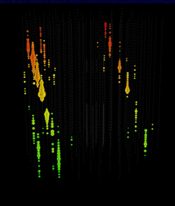Oct 21 2013
The Niels Bohr Institute is now officially admitted as a full member of the IceCube collaboration. IceCube is an enormous particle detector built into a cubic kilometer of ice at the South Pole. IceCube detects neutrinos, which are coming from space or are created by cosmic rays in the atmosphere.
 Observations of neutrinos.
Observations of neutrinos.
IceCube is comprised of 1 km3 of ice, which is packed full of instruments. The instruments in the detectors consist of 86 cables, each with 60 Digital Optical Modules (DOMs). Each cable is run through a hole melted with a hot water drill through the 2½ km thick ice. The detector is located 1½ km under the surface, so the detector begins 1½ km under the surface and ends at the bottom at a depth of 2½ km. It took almost seven years to build the detector, which was begun in early 2004 and was finished in December 2010.
The Digital Optical Modules are extremely sensitive. They measure neutrinos created by cosmic rays in the atmosphere or that come from space. Neutrinos interact very weakly with matter, which necessitates the enormous size of the detector. When they finally interact, charged particles are created, emitting radiation into the material. The Antarctic ice is the perfect material because it is ultra-clear.
Advantages of the polar ice
There are several reasons to place the detector deep in the ice at the South Pole. Firstly, the ice is clear. At such a depth, the pressure has pressed all of the bubbles out, so it is easier to detect neutrino interactions. Secondly, it is very dark in the ice. This is important, because when a neutrino interacts with the ice atoms, a particle called a muon is formed. High-energy muons emit a blue light that can be detected by the Digital Optical Modules, but this requires a very dark environment. The third reason for choosing the ice at the South Pole is that there is a lot of it. The IceCube detector is enormous. It uses 1 km3 of ice and is the largest neutrino detector in the world.
IceCube is an international project with researchers from 40 institutions in 11 countries. The IceCube group at the Niels Bohr Institute will be led by Jason Koskinen. In addition, Professor Subir Sarkar is attached to the project along with two PhD students and a postdoc. The group will concentrate on a proposed expansion of IceCube with the so-called Precision IceCube Next Generation Upgrade (PINGU), which among other things aims to solve the neutrinos’ so-called mass hierarchy.
Certain types of neutrinos created in the atmosphere over the North Pole will undergo quantum mechanical oscillations, which can convert them into another type of neutrinos before they are eventually detected by IceCube on the other side of the world. Such effects will be studied in much greater detail than before and it is expected that they will be able to determine which kinds of neutrinos are the lightest and which are the heaviest. The answer to this question is important in order to understand why all of the galaxies in the universe are made up of matter and not antimatter.
Furthermore, IceCube can search for neutrinos with energies in the GeV range from the Sun as well as for signs of the existence of the so-called ‘sterile neutrinos’, all of which could shed light on the mysterious dark matter of the universe.